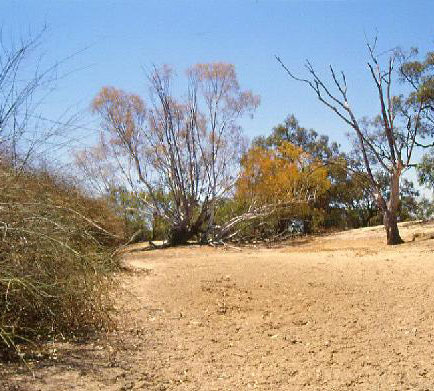Background
Drought impacts on flowing waters
The effects of drought on naturally flowing streams depend on many factors, including: rainfall patterns, the amount of water entering the stream especially from below-ground sources, groundwater levels, and the nature of the stream bed.
As water levels drop in the stream-channel, there are progressive consequences.
- The water shrinks away from the riverbank zone, from the river or stream edges where plants take root (littoral zone) and from backwaters, breaking the connection between the river and these backwaters and banks, and the floodplain beyond. This can result in considerable loss of habitat (the living places of organisms or communities) and reduced organic matter inputs, both dead and living.
- The stream flow may be very low for a long time. With less shade from riverbank vegetation, and high air temperatures, the water temperatures rise. Populations of waterbugs ('macroinvertebrates', which maintain water quality by processing organic matter, and are also fish food) are reduced. Fish are stressed; their growth and reproductive success may be affected, and they may die.
- Streams that continue to be fed by groundwater baseflow which is relatively rich in nutrients (nitrogen, phosphorus), but that do not have the usual volume of flow from upstream to dilute the nutrients, are liable to have a proliferation of threadlike 'filamentous' algae.
- Large floodplain rivers would normally flood in the wet season, refilling and refreshing the floodplain wetlands. Drought prevents that seasonal flooding. Billabongs that depend on the flooding slowly drain and evaporate away, and as the water shrinks the concentration of oxygen in the water diminishes, and water temperatures rise, leading ultimately to fish kills.
- Even robust trees at the streamside or on the floodplain, such as river red gum (Eucalyptus camaldulensis) or black box (Eucalyptus largiflorens), eventually become stressed and die when prolonged drought prevents them being flooded.
- Like standing waters, drought-affected stream waters will have higher concentrations of nutrients and salinity. Low water levels combined with loss of the usual seasonal flow patterns that trigger fish spawning, inhibit recruitment in fish populations - i.e. there are few or no young fish.
As drought continues, water may stop flowing altogether (crossing the 'cease-to-flow' threshold). The shallow areas - 'riffles' - dry up. These sections typically have well oxygenated shallow water when the stream is flowing. As the riffles dry up, the fish and invertebrates (e.g. aquatic insect larvae, crustacea) tend to congregate in pools in deeper parts of the stream channel. With no flow linking the pools, the normal through-transport of nutrients, biota and organic matter stops. With time, the conditions in the river pools will change as each pool becomes a separate standing-water environment, more subject to conditions in its surroundings, above and below ground.
These changes can cause severe stress to plants and animals that are more used to living in water that is flowing. Invertebrates, such as insect larvae, molluscs and crustaceans (e.g. mussels and hydropsychid caddisflies which feed by filtering food out of the flowing water), which were living in sections that have now become pools, noticeably disappear when the pool is isolated from flow. The assemblage of invertebrate fauna becomes more similar to that normally found in standing water bodies, such as farm dams. Farm-dam fauna is highly mobile, well adapted to severe conditions and largely made up of air-breathing predators such as hemipterans (bugs) and coleopterans (beetles).
Deep pools, especially shaded ones, may persist throughout the drought (if they are not depleted by stock watering or waterhole pumping). These are known as drought refuges or refugia. Others may dry up after a time, killing their inhabitants.
Human effects
Human activities in the catchments and streamside areas of flowing waters, now and in the past, can make a drought bite deeper into freshwater ecosystems.
However, management [link to Sustaining aquatic ecosystems through drought] can alleviate some of this, either through proactive planning and action between droughts, or by reactive responses during drought.
Desirable ecological condition for flowing waters
- Live and healthy bank vegetation.
- Few or no alien species in the stream.
- No extra nutrients entering the stream, e.g. from animal dung, sediment, or other contamination.
- No predation (via fishing, netting) by humans.
- Naturally declining water-level (no removal by humans or stock).
- Occasional additions of water to the stream (by rain or environmental water allocation).
- Refuge habitats exist within and around the stream, and are protected against interference from humans or pests.
See downloads:
Useful references
- Arthington, Bond, Lake, Marshall (in press)

